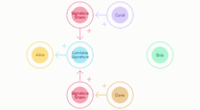As the name suggests, this guide talks about the Proof of stake in blockchain in detail. this article will focus on the below points:
Listen this article on audio
- Working of PoS
- Mining power
- Examples of PoS
So, let’s move towards our first point which is the Working of PoS.
How does proof of stake work?
The proof-of-stake model let the owners of a cryptocurrency not only stake coins but also create their own validator nodes. When you pledge your coins to be used for verifying transactions, is Staking. Your coins get locked up if you stake them, but while trading, you can unstake them.
The cryptocurrency’s proof-of-stake protocol can select a validator node to review the block when a block of transactions is ready to be processed. The validator needs to make sure that transactions in the block are up to date or true. Only after surety, they can attack the block to the blockchain and receive crypto rewards for their contribution. However, it is also possible that a validator may get a penalty in the form of losing staked holdings if they propose to add a block with false data.
Mining power in proof of stake
Participants who stake more coins are, the more the possibility to get selected to add new blocks. Because Mining power in proof of stake depends on the number of coins a validator is staking.
Each proof-of-stake protocol functions separately in how it selects validators. The selection process normally depends on other factors such as how long validators have been staking their coins and also on an element of randomization involved.
Although anyone could be chosen as a validator who is staking crypto, the chances of getting selected are very low if you’re staking a small amount. For example, to understand, your likelihood of being chosen as a validator would be about 0.001% if your coins make up 0.001% of the total amount that has been staked.
Examples of significant cryptocurrencies that use PoS:
- Cardano: As an example, let’s look at Cardano (CRYPTO: ADA), a significant cryptocurrency that implements proof of stake. It is a research-driven blockchain platform that prioritizes security and sustainability.
- Tezos (CRYPTO: XTZ) is a programmable blockchain designed with an on-chain upgrade mechanism for adaptability.
- Algorand (CRYPTO: ALGO) offers processing speeds of 1,000 transactions per second and to achieve this, it uses a two-tier blockchain structure.









-260x140.png)